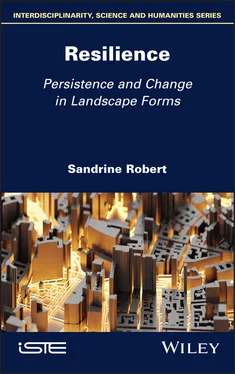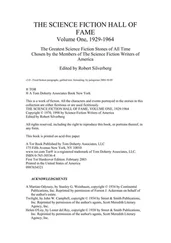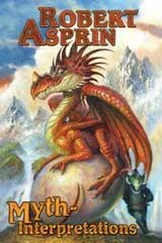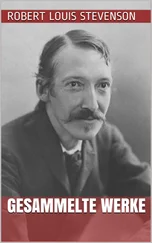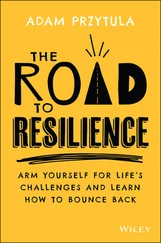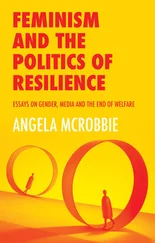As long as the Colosseum stands / Rome will stand; But when the Colosseum falls / Rome, too, will fall. And when Rome has fallen / Then the whole world will fall with it. 15 (Du Cange 1678, p. 407, translated)
According to this association of the notions of durée and dureté , the survival of a form over time results from the continued existence of the initial material object, if only in the form of ruins or traces. This assimilation of physical solidity with the capacity to last over time (durability), or even with the capacity to ensure the perennity of a societal choice, is at the heart of current debates on the subject of resilience; the approach is at odds with the notion of engineering resilience, where the response to natural disasters is found in the physical resistance of infrastructures ( section 5.2.4).
In the early 20th century, certain authors observed that the survival of forms in a landscape also relies on adjustments, whereby the original material forms are adapted to new functions. For example, it was noted that the ground footprint of medieval ramparts, later demolished, could still be seen in the curvature of urban thoroughfares (Brunhes 1925; Lavedan 1926a; Unwin 1981; Rossi 2001). P. Lavedan, writing during the period of reconstruction which followed the First World War, noted that towns or cities destroyed by a violent event (fire, war, etc.) grew back “naturally” following their earlier layout. Lavedan considered this phenomenon to be the result of a “natural inclination”, whereby “an owner will spontaneously rebuild his dwelling where it was before”. Once again, continuity appears as the result of memory and of uninterrupted ownership. Furthermore, in cases where destruction and reconstruction are separated by a longer period, “experience shows that […] in many cases, if even traces of a house remained, it will be rebuilt in the same place” 16 (Lavedan 1926a, pp. 92–93). Material continuity thus takes the place of memory. For Lavedan, permanence was the rule, while the creation of something new was the exception. The “natural inclination” of the owning masses, spontaneously rebuilding their homes in the same locations, thus corresponds to Saussure’s “speaking masses”.
The argument linking the permanence of ownership with a form of fixation of plot layouts through construction echoes the connection between durée and dureté described earlier. In the 1970s, the architect Pierre Pinon described the way in which certain Roman amphitheaters were progressively replaced by dwellings built on top of the ancient foundations (Pinon 1978). The parcel system constitutes a record of ways in which the land was used, even after it has ceased to accomplish a given function. Plots illustrate the contours of a monument, and these lines are “hardened” by buildings on these foundations. The footprint of extinct material structures thus “grows up” from the ground (Pinon 1994, p. 40) 17 . Describing the “mechanisms of memory in the parcel system”, the architect Bernard Gauthiez highlighted the links between legal and material criteria. He assigned a major role to the influence exerted by public power, guaranteeing the persistence of public land boundaries, while also noting that the persistence of boundaries is “strengthened by the tendency in urban settlements, at least from the late Middle Ages on, to construct dwellings along boundary lines” 18 (Gauthiez 1999, p. 19).
The persistence of older forms is not, therefore, exclusively a result of the persistence of the constructions themselves (shapes). Nevertheless, up until the 1990s, researchers still struggled to explain this persistence without resorting to the notion of continuum. There is an uninterrupted link between past and present, the result of multi-generational memory or, in the longer term, of the persistence of material remains, functions and the cadastral plan (Robert 2003a). This approach excludes the possibility of temporal hiatuses or non-linear temporalities.
Nevertheless, these early morphologists were well aware of the existence of change. This is evident in reactions to Meitzen’s suggestion that 19th-century parcel arrangements were a direct reflection of divisions established centuries earlier. Marc Bloch drew inspiration from Meitzen’s work, but situated his regressive method within a more dynamic view of history. Refusing to see the past as a still photograph, Bloch preferred a cinematic metaphor:
If we use our common sense, we shall see that the picture presented by the recent past is not an image we merely need to project over and over again in order to reproduce that of centuries more and more remote; what the recent past offers resembles rather the last reel of a film which we must try to unroll, resigned to the gaps we shall certainly discover, resolved to pay due regard to its sensitivity as a register of change. (Bloch 1966, p. xxx) 19
If, then, the landscape is in a state of perpetual change, how can we justify the use of cadastral plans, modern or contemporary maps to study ancient or medieval forms? According to A. Verhulst, these documents constitute a valid source in cases where there is no doubt in the matter of historical sequentiality (Verhulst 1995, p. 20). In order to deduct the past from the present or, conversely, the present from the past, the observed state must be precisely situated within a logical progression. The feasibility of regressive studies is thus contingent on the conceptualization of this progression or sequence.
In the 19th and the first half of the 20th century, evolutionism, as defined in the natural sciences, was seen as a coherent framework for describing change. Social scientists used these tools to compare different types of civilizations, based on an idea of progress, defined by Enlightenment philosophers as the ultimate goal for humanity. Evolution appeared to offer the means of attaining this goal, by means of a collective movement through a chain of states, with each clearly situated on a linear and cumulative timeline. Given a logical organization of time into a series of periods, it would then be possible to work backwards. In the words of Marc Bloch:
Let us then agree, since we have no choice, to follow the trail backwards, one careful step at a time, examining irregularities and variations as they come, avoiding the all-too-common error of trying to leap at a bound from the 18th century to the Neolithic age. (Bloch 1966, p. xxx) 20
Bloch’s reference to pierre polie in the original French (translated here as “Neolithic”) is significant, highlighting the role of technology as an essential factor in the attainment of different developmental stages (Latour 1991). This is further evident in the 19th-century classification of ancient societies: “stone age”, “iron age”, etc. Material and technical characteristics were essential criteria, used in the emerging sciences of ethnology and archeology to define different cultures.
The notion of age is ever-present in the study of morphology; some researchers expressed concern that the continued survival of past forms into the present might hinder the attainment of an optimum state by means of evolution. For Marcel Poëte, there was:
[...] a difficulty in reconciling the highly-evolved living conditions of the modern day with these persistent remains. How can ancient country paths, evolving into roads, be suitable for automobile circulation, in a city which has, itself, lasted from a past agricultural age to the current age of powerful industrialization without casting off its old skin? (Poëte 2000, p. 23) 21
The notion of age is also integral to the cycle of erosion concept in geomorphology, introduced by William M. Davis (1850–1934) and popularized in France by Henri Baulig (Masutti 2002). In this idealized model, landforms develop through a series of evolutions, step by step, finally resulting – when conditions allow – in a peneplain. The erosion cycle concept provides a means of explaining evolutions in a landscape. Under the effects of erosion, relief goes through a number of different “ages”, from youth to maturity and onto old age. Davis believed that, using this model, the past and future states of a relief form could be predicted based on observations of a present state (Meynier 1969, p. 58).
Читать дальше
